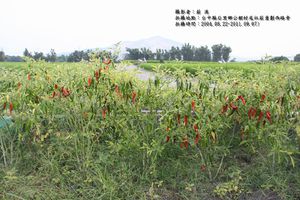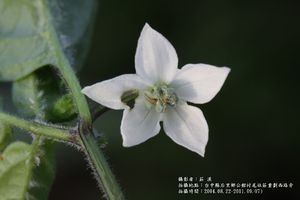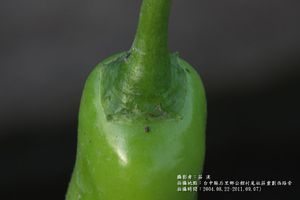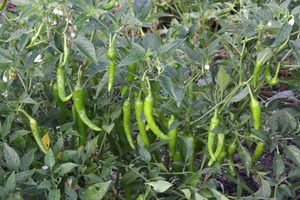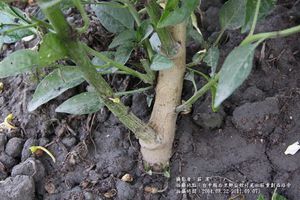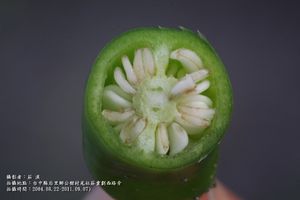番椒(辣椒)
出自台灣有毒中草藥毒性資料庫
(→植物圖片) |
(→活性研究) |
||
| (2個中途的修訂版本沒有顯示) | |||
| 第30行: | 第30行: | ||
|- | |- | ||
|| | || | ||
| - | [[ | + | [[檔案:辣椒-青實18.JPG|300px| ]] |
辣椒果實(未成熟) | 辣椒果實(未成熟) | ||
| 第79行: | 第79行: | ||
=='''活性成份'''== | =='''活性成份'''== | ||
| - | |||
| - | |||
<font size=4>'''果實'''[2]</font> | <font size=4>'''果實'''[2]</font> | ||
||<font size=4> | ||<font size=4> | ||
| 第90行: | 第88行: | ||
*6. Nonivamide | *6. Nonivamide | ||
</font> | </font> | ||
| - | |||
=='''活性研究'''== | =='''活性研究'''== | ||
| - | <font size=4 | + | <font size=4> |
*1. Capsaicin目前以ointment及cream方式用來治療肌肉疼痛、關節炎、扭傷,局部使用可以合併局部麻醉劑用來作為合併療法。其中cream也可以治療牛皮癬,降低搔癢及發炎[3, 4]。些許研究發現Capsaicin對控制血糖有幫助[5, 6],動物實驗中也顯示由Capsaicin誘發的 Substance P能夠有助於反轉小鼠糖尿病的作用[7]。在cancer方面研究指出辣椒素可以有效抑制前列腺癌,促進癌細胞凋亡[8],對於胃癌細胞也有促進凋亡的現象[9]。除此之外還有抗氧化[10, 11]、有效抑制血小板凝集[12, 13]、劑量稍微高一點可以抑制voltage-activated dihydropyridine-sensitive calcium channels[14]因此可以降低cardiac conduction及antiarrhythmic [15]等等。 | *1. Capsaicin目前以ointment及cream方式用來治療肌肉疼痛、關節炎、扭傷,局部使用可以合併局部麻醉劑用來作為合併療法。其中cream也可以治療牛皮癬,降低搔癢及發炎[3, 4]。些許研究發現Capsaicin對控制血糖有幫助[5, 6],動物實驗中也顯示由Capsaicin誘發的 Substance P能夠有助於反轉小鼠糖尿病的作用[7]。在cancer方面研究指出辣椒素可以有效抑制前列腺癌,促進癌細胞凋亡[8],對於胃癌細胞也有促進凋亡的現象[9]。除此之外還有抗氧化[10, 11]、有效抑制血小板凝集[12, 13]、劑量稍微高一點可以抑制voltage-activated dihydropyridine-sensitive calcium channels[14]因此可以降低cardiac conduction及antiarrhythmic [15]等等。 | ||
</font> | </font> | ||
| - | |||
== '''毒性研究''' == | == '''毒性研究''' == | ||
在2012年12月1日 (六) 02:49的最新修訂版本
| 中英文學名 | 科別 | 毒性 | 症狀 |
基本資料
|
科別 | 茄科Solanaceae |
|
屬名 | 番椒屬 Capsicum |
|
中文學名 | 番椒 |
|
拉丁學名 | Solanum violaceum Ortega |
|
英文名稱 | Capsicum |
|
中文俗名 | 牛角辣椒、青辣椒、辣椒、辣子、海椒、辣椒 |
植物圖片
|
辣椒 |
辣椒花 |
辣椒果萼 | |
|
辣椒果實(未成熟) |
辣椒莖 |
辣椒果實橫切面 |
番椒簡介
一或多年生灌木狀草本,株高50-90公分[1]。
外觀簡述
|
莖 | 莖直立多分枝[1] |
|
葉 | 單葉、互生,卵狀披針形,葉片長5至9公分,寬1至2公分[1] |
|
花 | 白色、淡黃綠色[1] |
|
果實 | 紅色或綠色 |
產地
熱帶美洲原產,台灣引進為經濟作物栽培[1]
使用情況
果有溫中散寒,健胃消食,除濕發汗,興奮、刺激、活血、消腫等功效,也可治療風濕性關節炎、腮腺炎的疼痛。[1]
活性成份
果實[2] ||
- 1. Capsaicin
- 2. Dihydrocapsaicin
- 3. Nordihydrocapsaicin
- 4. Homodihydrocapsaicin
- 5. Homocapsaicin
- 6. Nonivamide
活性研究
- 1. Capsaicin目前以ointment及cream方式用來治療肌肉疼痛、關節炎、扭傷,局部使用可以合併局部麻醉劑用來作為合併療法。其中cream也可以治療牛皮癬,降低搔癢及發炎[3, 4]。些許研究發現Capsaicin對控制血糖有幫助[5, 6],動物實驗中也顯示由Capsaicin誘發的 Substance P能夠有助於反轉小鼠糖尿病的作用[7]。在cancer方面研究指出辣椒素可以有效抑制前列腺癌,促進癌細胞凋亡[8],對於胃癌細胞也有促進凋亡的現象[9]。除此之外還有抗氧化[10, 11]、有效抑制血小板凝集[12, 13]、劑量稍微高一點可以抑制voltage-activated dihydropyridine-sensitive calcium channels[14]因此可以降低cardiac conduction及antiarrhythmic [15]等等。
毒性研究
- 症狀[16]
- 1. 皮膚部位發紅並有灼熱(63%)、刺痛感(42%)、搔癢、噁心嘔吐、水腫。
- 有毒成分
- Capsaicin
- 中毒劑量[19]
- Rat LD50 (oral toxicity)
- male 161.2 mg/kg
- female 148.1 mg/kg
- Mouse LD50 (oral toxicity)
- male 118.8 mg/kg
- female 97.4 mg/kg
- Rat LD50 (oral toxicity)
- 機轉
- Capsaicin為transient receptor potential vanilloid receptor 1 (TRPV1)之高選擇性致效劑[17],當TRPV1活化時會產生noxious stimuli, heat, extracellular acidification, 及integrates作用[18]。
- 神經毒性
- 1. 1996年研究指出,給予大劑量capsaicin於老鼠發現主要毒性症狀有流口水、皮膚紅腫、呼吸緩慢等等。有些動物研究發現會有顫抖、呼吸困難甚至是死亡[19] 。
- 心臟毒性
- 2005年研究指出給予靜脈注射capsaicin於狗,發現急性單一劑量capsaicin1 mg/kg會明顯增加血壓、心跳等等急性心血管作用產生(例如:transient tachycardia and hypertension)[20]。
- 基因毒性
- 基因毒性在ame test跟human peripheral blood lymphocytes (HPBL) assays之chromosomal aberration等等試驗皆沒有出現基因突變的現象產生,會產生mutation的機率很低[21]。
毒性分級
參考文獻
1. 呂炎周. 台灣藥用植物名錄. In Edition 嘉義: 蘭潭彩色印刷股份有限公司 2006.
2. Howard L. Constant and Geoffrey A. Cordel DPW. Nonivamide, a Constituent of Capsicum oleoresi. J. Nat. Prod. 1996; 59 (4): pp 425–426.
3. Glinski W, Glinska-Ferenz M, Pierozynska-Dubowska M. Neurogenic inflammation induced by capsaicin in patients with psoriasis. Acta Derm Venereol 1991; 71: 51-54.
4. Arnold WP, van de Kerkhof PC. Topical capsaicin in pruritic psoriasis. J Am Acad Dermatol 1994; 31: 135.
5. Lejeune MP, Kovacs EM, Westerterp-Plantenga MS. Effect of capsaicin on substrate oxidation and weight maintenance after modest body-weight loss in human subjects. Br J Nutr 2003; 90: 651-659.
6. Razavi R, Chan Y, Afifiyan FN et al. TRPV1+ sensory neurons control beta cell stress and islet inflammation in autoimmune diabetes. Cell 2006; 127: 1123-1135.
7. Tsui H, Razavi R, Chan Y et al. 'Sensing' autoimmunity in type 1 diabetes. Trends Mol Med 2007; 13: 405-413.
8. Mori A, Lehmann S, O'Kelly J et al. Capsaicin, a component of red peppers, inhibits the growth of androgen-independent, p53 mutant prostate cancer cells. Cancer Res 2006; 66: 3222-3229.
9. Chow J, Norng M, Zhang J, Chai J. TRPV6 mediates capsaicin-induced apoptosis in gastric cancer cells--Mechanisms behind a possible new "hot" cancer treatment. Biochim Biophys Acta 2007; 1773: 565-576.
10. Okada Y, Okajima H. Antioxidant effect of capsaicin on lipid peroxidation in homogeneous solution, micelle dispersions and liposomal membranes. Redox Rep 2001; 6: 117-122.
11. Rosa A, Deiana M, Casu V et al. Antioxidant activity of capsinoids. J Agric Food Chem 2002; 50: 7396-7401.
12. Hogaboam CM, Wallace JL. Inhibition of platelet aggregation by capsaicin. An effect unrelated to actions on sensory afferent neurons. Eur J Pharmacol 1991; 202: 129-131.
13. Wang JP, Hsu MF, Teng CM. Antiplatelet effect of capsaicin. Thromb Res 1984; 36: 497-507.
14. Sim JH, Kim YC, Kim SJ et al. Capsaicin inhibits the voltage-operated calcium channels intracellularly in the antral circular myocytes of guinea-pig stomach. Life Sci 2001; 68: 2347-2360.
15. D'Alonzo AJ, Grover GJ, Darbenzio RB et al. In vitro effects of capsaicin: antiarrhythmic and antiischemic activity. Eur J Pharmacol 1995; 272: 269-278.
17. Caterina MJ, Schumacher MA, Tominaga M et al. The capsaicin receptor: a heat-activated ion channel in the pain pathway. Nature 1997; 389: 816-824.
| 中英文學名 | 科別 | 毒性 | 症狀 |
